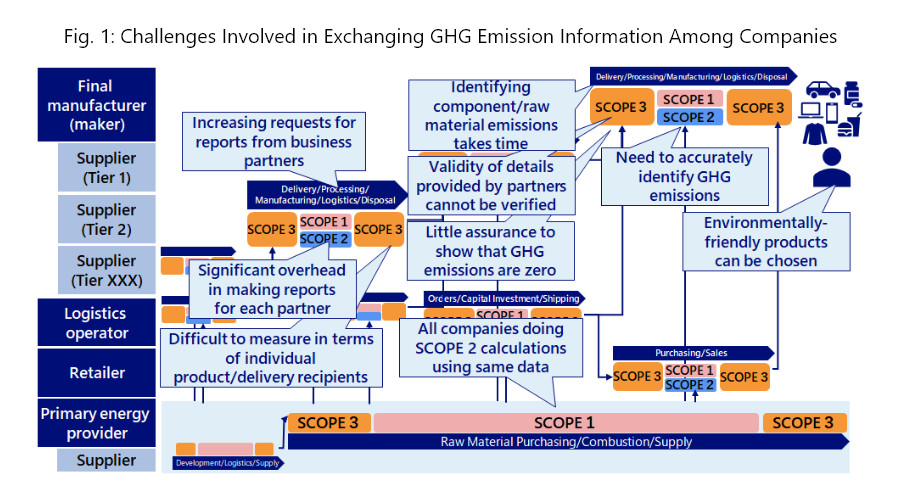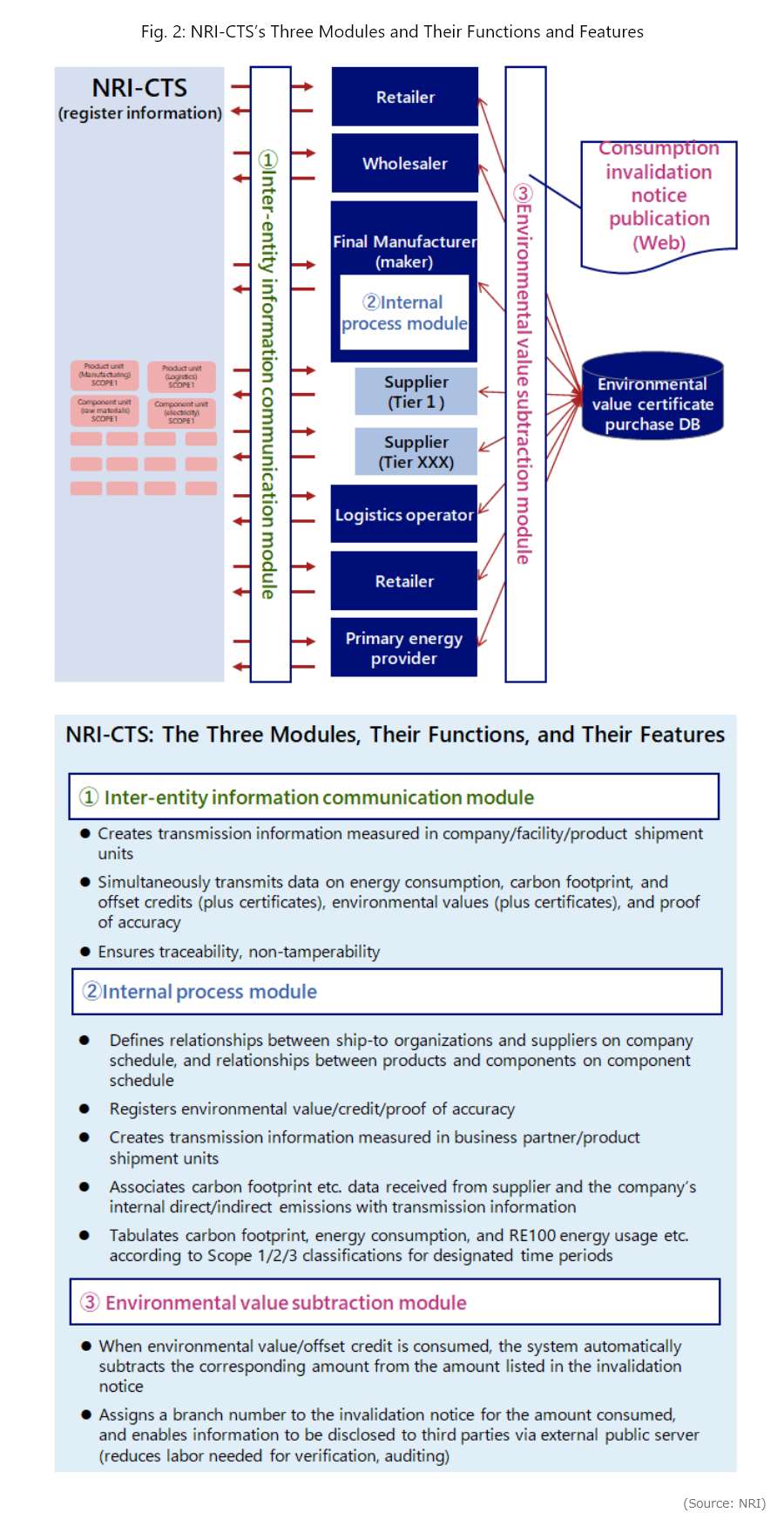Nomura Research Institute, Ltd. (“NRI”), a leading provider of consulting services and system solutions, has developed a prototype for a “carbon tracing system (NRI-CTS)1 ” that will enable companies to trace emissions-related information indicating levels of CO2 and other greenhouse gases (GHG) in their own supply chains. A Proof-of-Concept (PoC) test will be commenced from December 2021 until March 2022 to apply NRI-CTS in tracking TCFD compliance and tracing the status of product-specific GHG emissions.
As an initiative to help companies decarbonize their operations, efforts are now being made by companies to measure and compute the GHG amounts that they and their business partners emit according to certain categories (SCOPE 1, 2, 3), with the companies then disclosing the results. In making these disclosures, many firms tend to ask the various companies that make up their own supply chains to voluntarily provide data on their GHG emissions (supply chain emissions), which are known as SCOPE 3 emissions. However, this poses a variety of challenges, for instance by placing a heavy burden on companies to handle the individual surveys done by their business partners, and by requiring that they spend time confirming the accuracy of emissions calculations and verifying whether their partners have obtained RE100 2 certification. Going forward, as more companies get involved in disclosing their GHG emissions, these challenges are likely to become a significant strain for all companies (fig. 1).
There are two accepted methods for making SCOPE 3 disclosures. One involves companies receiving emissions data provided by their business partners (actual values), and the other involves having the companies themselves collect data on emissions activity and then multiply this activity data by applicable emission factors (basic unit calculation) 3 . While it is common for companies to adopt the latter method, the emission factors themselves are not frequently revised, and thus the results of efforts to reduce GHG emissions by supply chain companies do not get reflected in a timely manner.

To help companies ensure that their supply chain partners’ achievements toward realizing a decarbonized society—through reducing their per-unit energy consumption, promoting the use of 100% renewable energy under the RE100 initiative, and undertaking carbon offset programs—can be incorporated in their own SCOPE 3 emissions data in a timely manner, they need a way to identify emissions in their supply chains using actual values. With NRI-CTS, NRI has set out to accomplish the following four points to assist companies in identifying their emissions amounts using actual values (fig. 2).
1.Helping Companies Identify the Status of Their Supply Chain GHG Emissions Using Actual Values, and Tracing Emissions Amounts
NRI-CTS communicates the status of GHG emissions in supply chains at the company level, the product level, and various other resolutions, by ensuring traceability and eliminating the risk of data tampering. The system functions in this capacity by automatically subtracting (1) environmental values reflecting a company’s in-house consumption and (2) the company’s energy credits, and by releasing this data so that the recipient can verify how much has been subtracted.

2.User-Friendly Interface Enables Information to Easily Be Shared Even with Longtail Business Partners
NRI-CTS features web-based certificate and business relationship registration, information entry, and editing functions, enabling information to be transmitted and received in a similar manner to email. The system is also equipped with data import and received data export features, as well as an aggregating feature with designated time intervals for received data, and these features can even be used for TCFD reporting.
3.Energy Consumption, Offset, and Accuracy-Related Information Are All Communicated Simultaneously
NRI-CTS can communicate not only a company’s carbon footprint data, but also its energy consumption data etc., while at the same time also conveying data about its carbon offset amount, renewable energy usage, GHG emissions reductions, and even information about the accuracy of its GHG emissions measurements and calculations (ISO14001 and greenhouse gas (GHG) third-party verification results).
4.Aligning with Other Companies’ SCOPE 1 Efforts
NRI-CTS focuses on collaborations and coordination among the key players, and when it comes to visualizing SCOPE 1 emissions, the system not only looks at the main operating companies involved, but also seeks prospective synergies with solutions from other system providers.
Going forward, NRI will continue contributing to the realization of a decarbonized society, sharing the achievements of corporate climate change measures with the public in a timely manner.
-
●
Related materials
NRI Research Paper Knowledge Creation and Integration June 2021, “Special Feature: The Impact of Achieving Carbon Neutrality by 2050”
https://www.nri.com/jp/knowledge/publication/cc/chitekishisan/lst/2021/06
-
1
Filed for patent and trademark protection.
-
2
For details, visit the following URL: https://www.env.go.jp/earth/re100.html
-
3
The specific calculation methods and emission factors are published at the Environment Ministry’s homepage (link below).
https://www.env.go.jp/earth/ondanka/supply_chain/gvc/supply_chain.html
Contact Us
Media Inquiries:
Sangi Tamaoka, Kayano Umezawa
Corporate Communications Department
Nomura Research Institute, Ltd.
TEL:+81-3-5877-7100
E-mail:
kouhou@nri.co.jp
Inquiries about this matter:
Hisashi Ono, Partner
Tetsuji Uemura, Sustainability Business Consulting Department
Nomura Research Institute, Ltd.
E-mail: nri-cts-pr@nri.co.jp